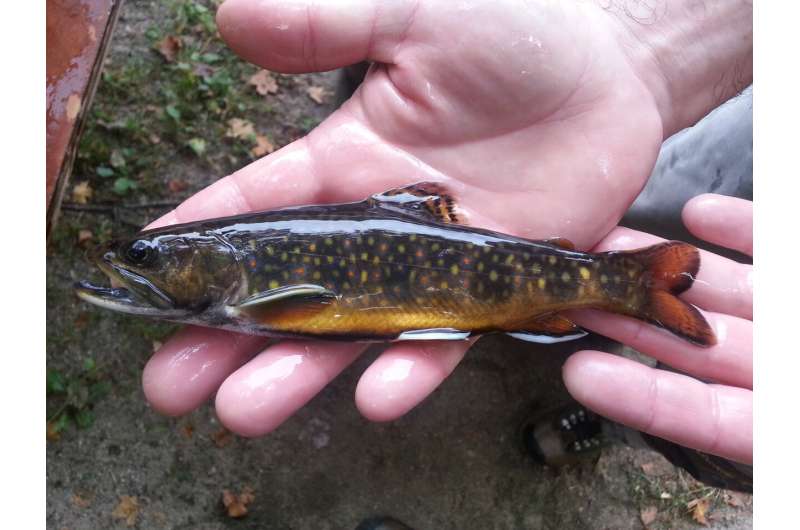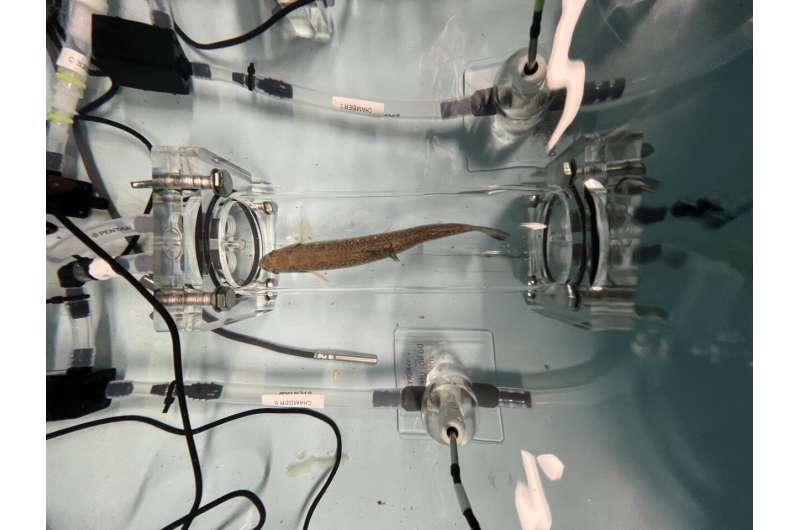This article has been reviewed according to Science X's editorial process and policies. Editors have highlighted the following attributes while ensuring the content's credibility:
fact-checked
peer-reviewed publication
trusted source
proofread
Why are fish getting smaller as waters warm? It's not their gills, finds study

A collaborative team of scientists led by the University of Massachusetts Amherst recently found that there is no physiological evidence supporting a leading theory—which involves the surface area of fish gills—as to why many fish species are "shrinking" as waters grow warmer due to climate change. Known as the Gill Oxygen Limitation (GOL) theory, it has been proposed as the universal mechanism explaining fish size and has been used in some predictions of future global fisheries yields.
However, the researchers, representing the National Oceanic and Atmospheric Administration, U.S. Geological Survey, the University of California Davis as well as UMass Amherst, conducted a series of long-term experiments on brook trout and found that though increased temperatures do lead to significantly decreased body size, gill surface area did not explain the change. The results of the study were recently published in the Journal of Experimental Biology.
"We know that global climate change is happening and our oceans and rivers are getting warmer," says Joshua Lonthair, lecturer in biology at UMass Amherst and the paper's lead author. "And we know that many animals—not just fish—are growing to smaller adult body sizes under warmer temperatures. We even have a name for this, the Temperature Size Rule. But despite decades of research, we still don't understand why size decreases as temperature increases."
In both marine and freshwater fish species, rising water temperatures have a critical effect on metabolism, reproduction and other life functions, but a critical factor that most of the models underlying fisheries management rely on is fish size. Commercial fisheries are often regulated by tonnage, and when fish shrink, it takes more of them to fill out a ton. Lower weight is also linked to reduced reproduction. Altogether, this means that managers need to adjust their models for our changing world.
But how?
A leading theory, GOL, holds that fish growth is limited by how much oxygen gills can pull from the water. As the water warms, the biochemical processes of the fish speed up and require more oxygen. The GOL contends that gills have limited surface area that constrains the amount of oxygen they can supply, and thus, fish cannot grow as large under warm water conditions. Therefore, fish are "shrinking" to fit the limited oxygen that their gills can supply.
The GOL theory underlies widely cited model projections of drastic reductions in future global fisheries yields, including some used by the International Union for Conservation of Nature—but it has never been directly tested.
"We noticed that prior studies on GOL rely on data repurposed from other, unrelated research projects that weren't designed to specifically to test the theory," says Lisa Komoroske, assistant professor in environmental conservation at UMass Amherst and the paper's senior author. "We designed a series of long-term experiments which collectively are the first effort to empirically test GOL."

Specifically, Lonthair, Komoroske and their colleagues wanted to see how the three key ingredients of GOL—growth, energetic demands and the surface area of fish gills—changed as water temperatures increased. To do this they turned to brook trout, which are ideal test subjects: scientists already know a great deal about the species, they are fast-growing, economically and ecologically important to the Northeastern U.S. and they are comparatively easy to work with.
Once they had their test subjects—small fry that initially weighed between one and two grams each—they were placed into tanks, some of which contained normal, 15º Celsius water, and some of which contained water warmed to 20º Celsius. The fish were weighed and measured at the start of the experiment, and then monthly thereafter. Their oxygen consumption was also measured at two weeks, three months and six months, which is a way of ascertaining metabolic rate. Finally, the researchers collected gill samples from the same fish to measure changes in their gill surface area.
Once they began analyzing their data, a few things became clear: The brook trout in the warmer tanks were smaller, as expected, and in line with the Temperature Size Rule. However, the gill surface area was more than enough to meet the fishes' energetic demands, which means that their growth was not limited by the surface area of the gills, as GOL predicts.
Furthermore, the team found that while the warm-tank fishes' metabolic rates did increase at the three-month mark, by six months their oxygen rate returned to normal, suggesting that the fish could adjust their physiology over time to account for the increased water temperatures.
"Oxygen use may still be an important limiting factor in fish size," says Lonthair, "but, taken together, our findings show that GOL cannot predict what we're seeing, and this has implications for predicting climate impacts on future fisheries and ecosystems."
"Our work highlights the importance of interdisciplinarity," adds Komoroske. "Fisheries and macroecology scientists tend to work on the population and species level, while the physiologists tend to work on the individual and cellular levels. But these are academic distinctions, not natural ones, and if we're going to help fish survive warming waters, we need to work across biological scales and join the insights of all these fields."
So what is the mechanism governing fish size and temperature?
"We don't know yet," says Lonthair. "And it may not be a single mechanism—it may be a host of factors, including oxygen use. We need more interdisciplinary long-term studies so that we can understand how best to adjust to our warming world."
More information: Smaller body size under warming is not due to gill-oxygen limitation in a cold-water salmonid, Journal of Experimental Biology (2024). DOI: 10.1242/jeb.246477
Journal information: Journal of Experimental Biology
Provided by University of Massachusetts Amherst

















